07. TS forecasting in TF
(참고) udemy - TF Developer in 2022
(1) TS forecasting & classification
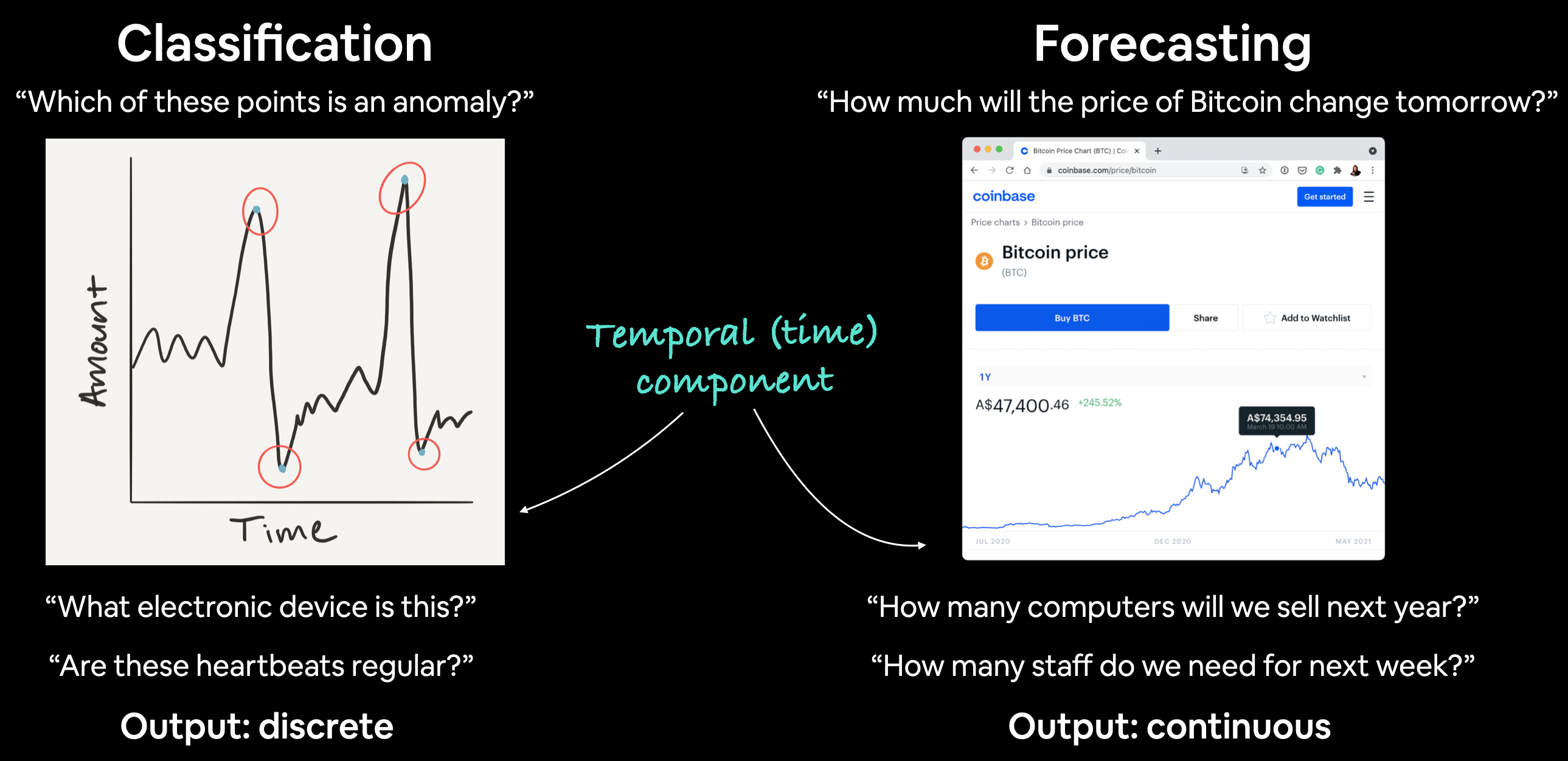
| Examples | Output | |
|---|---|---|
| Classification | Anomaly detection, time series identification |
Discrete |
| Forecasting | Predicting stock market prices, forecasting future demand for a product, stocking inventory requirements |
Continuous |
(2) Trend, Seasonality, Cycle

(3) Univariate vs Multivariate TS
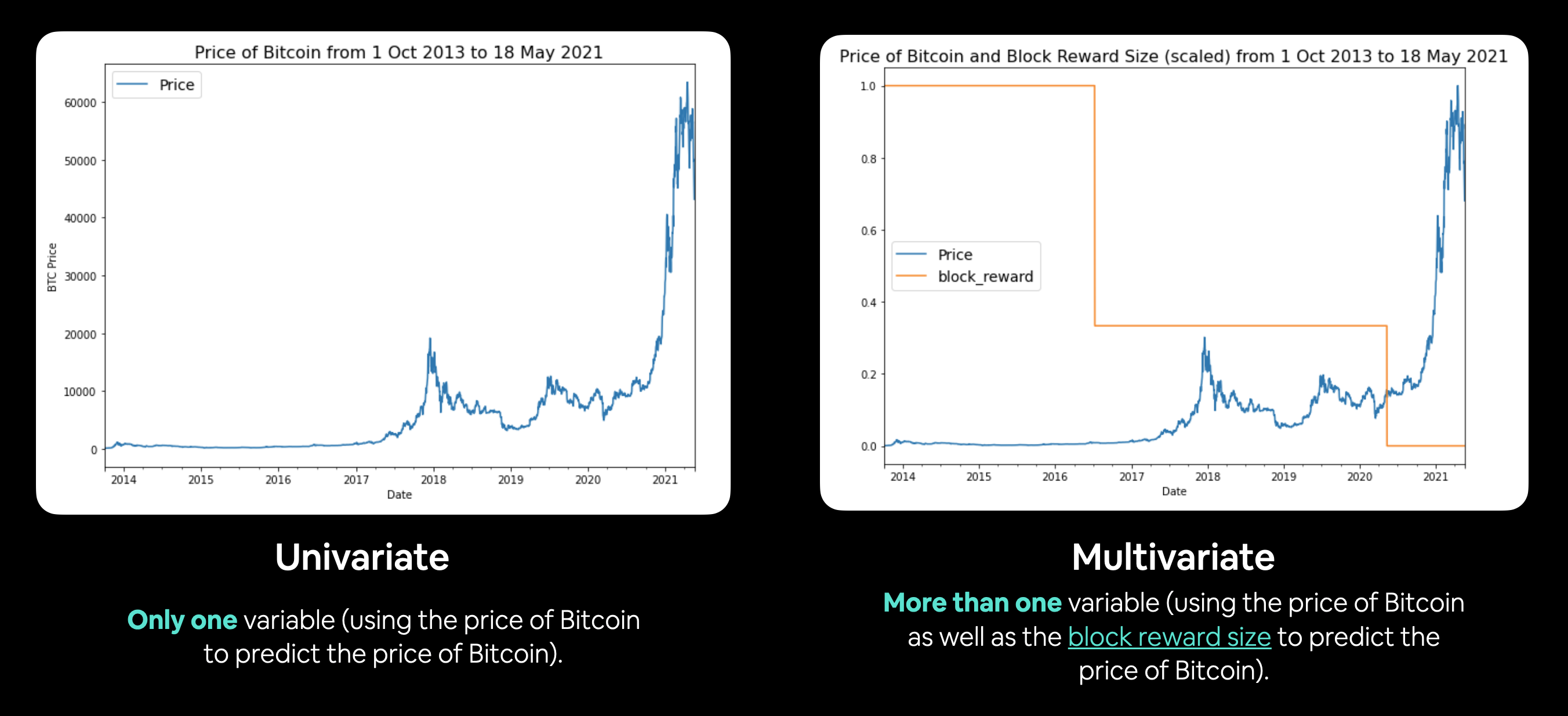
(4) Train & Test split in TS
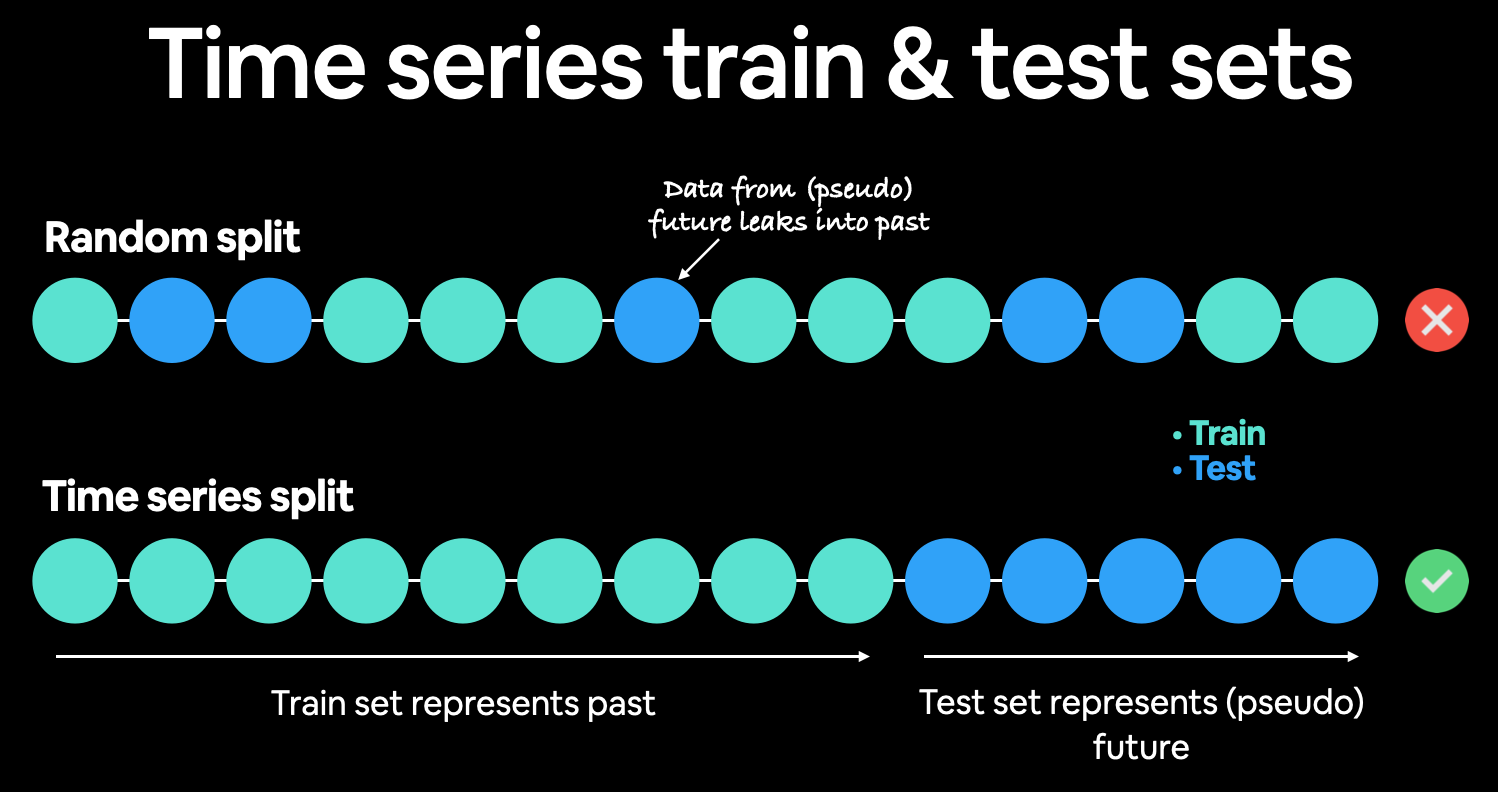
split_size = int(0.8 * len(prices))
X_train, y_train = timesteps[:split_size], prices[:split_size]
X_test, y_test = timesteps[split_size:], prices[split_size:]
(5) Evaluating TS models
a) scale-dependent errors
b) percentage errors
- MAPE
tf.keras.metrics.mean_absolute_percentage_error()](https://www.tensorflow.org/api_docs/python/tf/keras/losses/MAPE)
- sMAPE
- Recommended not to be used by Forecasting: Principles and Practice, though it is used in forecasting competitions.
c) scaled errors
-
MASE
-
sktime’s
mase_loss() -
assuming no seasonality
def mean_absolute_scaled_error(y_true, y_pred): mae = tf.reduce_mean(tf.abs(y_true - y_pred)) mae_naive_no_season = tf.reduce_mean(tf.abs(y_true[1:] - y_true[:-1])) return mae / mae_naive_no_season -
(6) Baseline models
| Model/Library Name | Resource |
|---|---|
| Moving average | https://machinelearningmastery.com/moving-average-smoothing-for-time-series-forecasting-python/ |
| ARIMA (Autoregression Integrated Moving Average) | https://machinelearningmastery.com/arima-for-time-series-forecasting-with-python/ |
| sktime (Scikit-Learn for time series) | https://github.com/alan-turing-institute/sktime |
| TensorFlow Decision Forests (random forest, gradient boosting trees) | https://www.tensorflow.org/decision_forests |
| Facebook Kats (purpose-built forecasting and time series analysis library by Facebook) | https://github.com/facebookresearch/Kats |
| LinkedIn Greykite (flexible, intuitive and fast forecasts) | https://github.com/linkedin/greykite |
(7) Windowing Dataset
[0, 1, 2, 3, 4, 5, 6] -> [7]
[1, 2, 3, 4, 5, 6, 7] -> [8]
[2, 3, 4, 5, 6, 7, 8] -> [9]
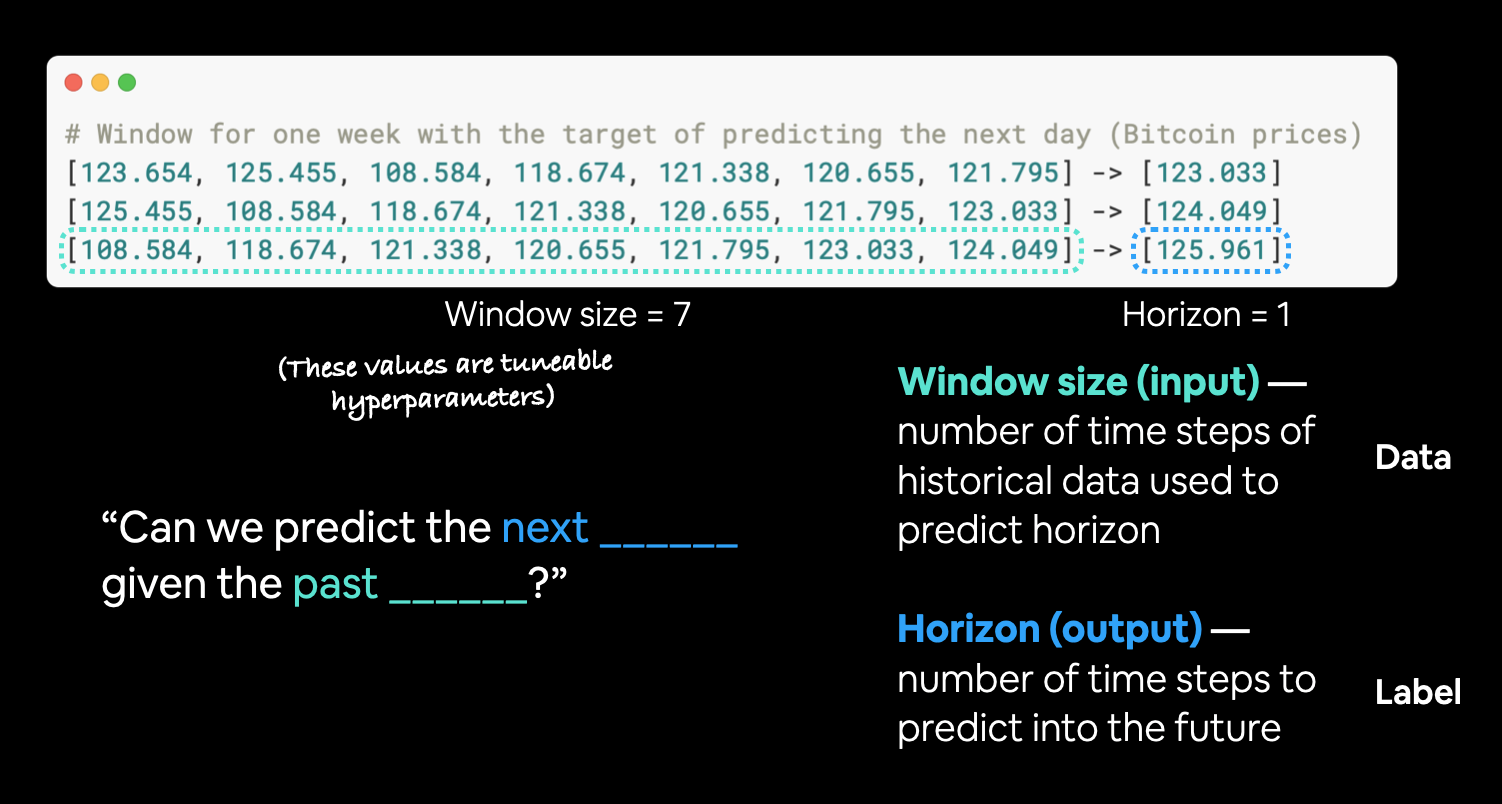
(8) Checkpoint
import os
def create_model_checkpoint(model_name, save_path="model_experiments"):
return tf.keras.callbacks.ModelCheckpoint(filepath=os.path.join(save_path, model_name),
verbose=0,
save_best_only=True)
(9) model 0 : naive forecast
가장 마지막 값을 예측값으로
naive_forecast = y_test[:-1]
(10) model 1 : FC
Window = 7, Horizon = 1
HORIZON = 1
model_1 = tf.keras.Sequential([
layers.Dense(128, activation="relu"),
layers.Dense(HORIZON, activation="linear") ],
name="model_1_dense")
Window = 30, Horizon = 7
HORIZON = 7
model_2 = tf.keras.Sequential([
layers.Dense(128, activation="relu"),
layers.Dense(HORIZON) ],
name="model_2_dense")
(11) model 2 : Conv1D
- axis=1 (2번째 차원, channel 차원)에 1 넣어주기
model_4 = tf.keras.Sequential([
layers.Lambda(lambda x: tf.expand_dims(x, axis=1)),
layers.Conv1D(filters=128, kernel_size=5, padding="causal", activation="relu"),
layers.Dense(HORIZON)],
name="model_4_conv1D")
(12) model 3 : RNN (LSTM)
inputs = layers.Input(shape=(WINDOW_SIZE))
#------------------------------------------------------------------------------------#
x = layers.Lambda(lambda x: tf.expand_dims(x, axis=1))(inputs)
x = layers.LSTM(128, activation="relu")(x)
output = layers.Dense(HORIZON)(x)
#------------------------------------------------------------------------------------#
model_5 = tf.keras.Model(inputs=inputs, outputs=output, name="model_5_lstm")
(13) Ensembling results
def make_ensemble_preds(ensemble_models, data):
ensemble_preds = []
for model in ensemble_models:
preds = model.predict(data)
ensemble_preds.append(preds)
return tf.constant(tf.squeeze(ensemble_preds))
ensemble_preds = make_ensemble_preds(ensemble_models=ensemble_models,
data=test_dataset)
Prediction Interval
Prediction Intervals for Deep Learning Neural Networks
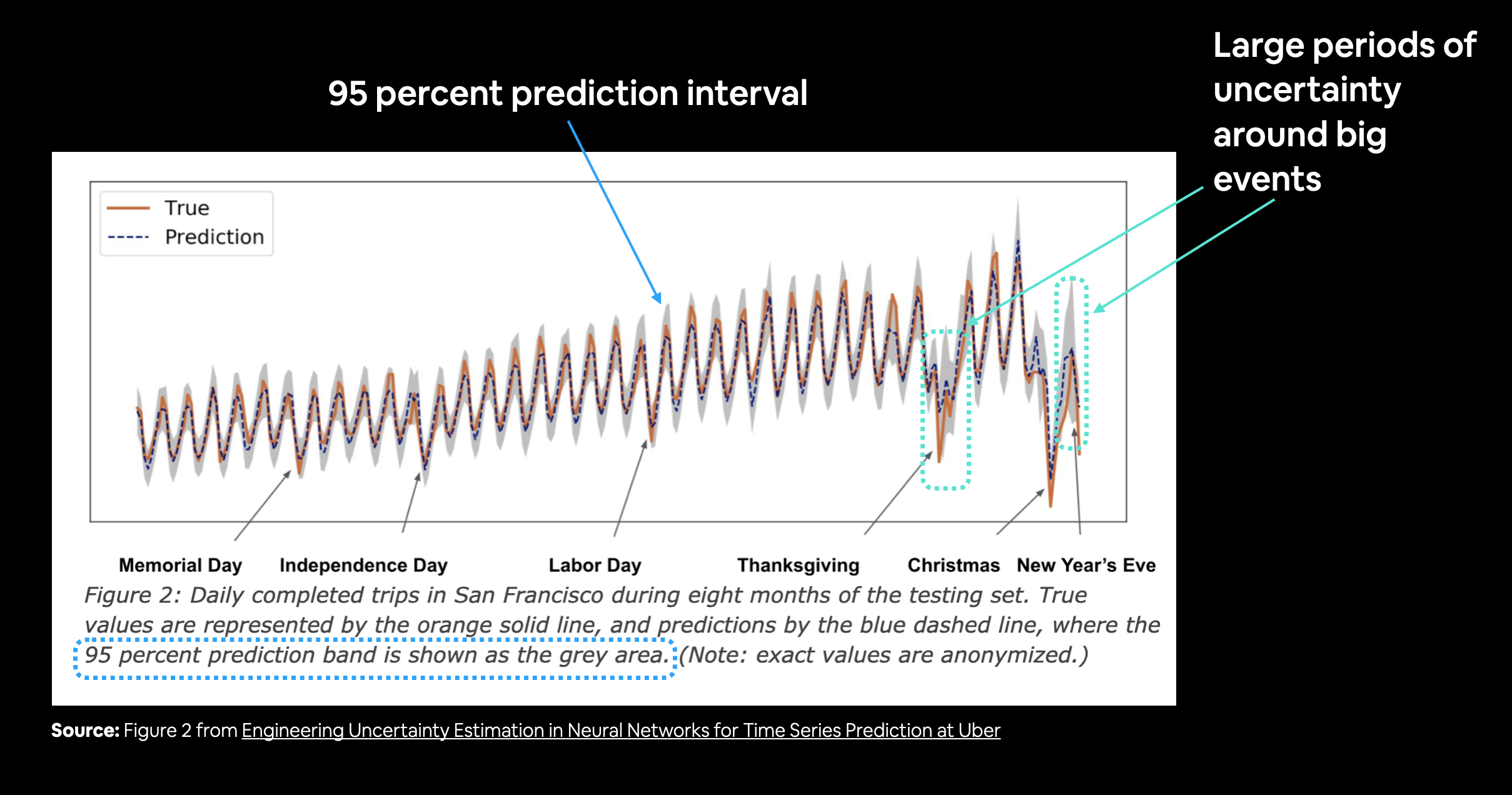
One way of getting the 95% condfidnece prediction intervals for a deep learning model is the bootstrap method:
- Take the predictions from a number of randomly initialized models
- Measure the standard deviation of the predictions
- Multiply standard deviation by 1.96
- (assuming the distribution is Gaussian, 95% of observations fall within 1.96 standard deviations of the mean, this is why we initialized our neural networks with a normal distribution)
- To get the prediction interval upper and lower bounds, add and subtract the value obtained in (3) to the mean/median of the predictions made in (1)
def get_upper_lower(preds):
preds_mean = tf.reduce_mean(preds, axis=0)
std = tf.math.reduce_std(preds, axis=0)
interval = 1.96 * std
lower, upper = preds_mean - interval, preds_mean + interval
return lower, upper
lower, upper = get_upper_lower(preds=ensemble_preds)
ensemble_median = np.median(ensemble_preds, axis=0)
offset=500
plt.figure(figsize=(10, 7))
plt.plot(X_test.index[offset:], y_test[offset:], "g", label="Test Data")
plt.plot(X_test.index[offset:], ensemble_median[offset:], "k-", label="Ensemble Median")
plt.xlabel("Date")
plt.ylabel("BTC Price")
plt.fill_between(X_test.index[offset:],
(lower)[offset:],
(upper)[offset:], label="Prediction Intervals")
plt.legend(loc="upper left", fontsize=14)
